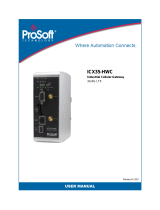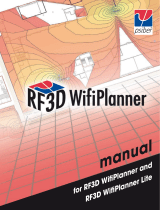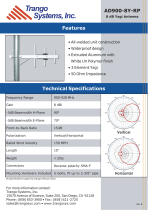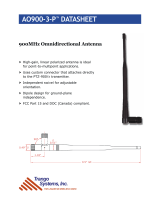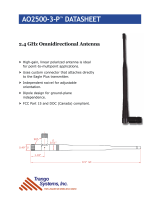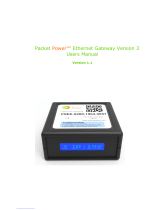Page is loading ...

RLX2-IFHxE
Industrial Wireless
Industrial Frequency Hopping
Ethernet Radios
May 28, 2014
USER MANUAL

Your Feedback Please
We always want you to feel that you made the right decision to use our products. If you have suggestions, comments,
compliments or complaints about our products, documentation, or support, please write or call us.
ProSoft Technology
5201 Truxtun Ave., 3rd Floor
Bakersfield, CA 93309
+1 (661) 716-5100
+1 (661) 716-5101 (Fax)
www.prosoft-technology.com
© 2014 ProSoft Technology, Inc. All rights reserved.
RLX2-IFHxE User Manual
May 28, 2014
ProSoft Technology
®
, is a registered Copyright of ProSoft Technology, Inc. All other brand or product names are or
may be trademarks of, and are used to identify products and services of, their respective owners.
In an effort to conserve paper, ProSoft Technology no longer includes printed manuals with our product shipments.
User Manuals, Datasheets, Sample Ladder Files, and Configuration Files are provided on the enclosed DVD and are
available at no charge from our web site: http://www.prosoft-technology.com
Content Disclaimer
This documentation is not intended as a substitute for and is not to be used for determining suitability or reliability of
these products for specific user applications. It is the duty of any such user or integrator to perform the appropriate
and complete risk analysis, evaluation and testing of the products with respect to the relevant specific application or
use thereof. Neither ProSoft Technology nor any of its affiliates or subsidiaries shall be responsible or liable for
misuse of the information contained herein. Information in this document including illustrations, specifications and
dimensions may contain technical inaccuracies or typographical errors. ProSoft Technology makes no warranty or
representation as to its accuracy and assumes no liability for and reserves the right to correct such inaccuracies or
errors at any time without notice. If you have any suggestions for improvements or amendments or have found errors
in this publication, please notify us.
No part of this document may be reproduced in any form or by any means, electronic or mechanical, including
photocopying, without express written permission of ProSoft Technology. All pertinent state, regional, and local safety
regulations must be observed when installing and using this product. For reasons of safety and to help ensure
compliance with documented system data, only the manufacturer should perform repairs to components. When
devices are used for applications with technical safety requirements, the relevant instructions must be followed.
Failure to use ProSoft Technology software or approved software with our hardware products may result in injury,
harm, or improper operating results. Failure to observe this information can result in injury or equipment damage.
© 2014 ProSoft Technology. All rights reserved.
Printed documentation is available for purchase. Contact ProSoft Technology for pricing and availability.

Important Safety Information
The following Information and warnings pertaining to the radio module must be heeded.
"This Equipment is suitable For Use in Class I, Division II, Groups A, B, C, D or Non-Hazardous Locations Only"
"WARNING – EXPLOSION HAZARD – Substitution of any components may impair suitability for Class I,
Division 2"
"WARNING - EXPLOSION HAZARD - Do not disconnect equipment unless power has been removed or the
area is known to be non-hazardous".
Device must be powered by a Class 2 Power Source.
Device is open-type and is to be installed in an enclosure suitable for the environment that utilizes a tool removable
door/cover.
"THIS DEVICE CONTAINS A TRANSMITTER MODULE, FCC ID: . PLEASE SEE FCC ID LABEL ON BACK OF
DEVICE."
"THIS DEVICE USES AN INTERNAL COMPACT FLASH RADIO MODULE AS THE PRIMARY RADIO
COMPONENT. THE COMPACT FLASH RADIO MODULE DOES NOT HAVE AN FCC ID LABEL. THE COMPACT
FLASH RADIO MODULE HAS NO USER SERVICEABLE PARTS."
"THIS DEVICE COMPLIES WITH PART 15 OF THE FCC RULES. OPERATION IS SUBJECT TO THE FOLLOWING
TWO CONDITIONS: (1) THIS DEVICE MAY NOT CAUSE HARMFUL INTERFERENCE, AND (2) THIS DEVICE
MUST ACCEPT ANY INTERFERENCE RECEIVED, INCLUDING INTERFERENCE THAT MAY CAUSE
UNDESIRED OPERATION."
"CHANGES OR MODIFICATIONS NOT EXPRESSLY APPROVED BY THE PARTY RESPONSIBLE FOR
COMPLIANCE COULD VOID THE USER’s AUTHORITY TO OPERATE THE EQUIPMENT."
Industry Canada Requirements
"THIS DEVICE HAS BEEN DESIGNED TO OPERATE WITH AN ANTENNA HAVING A MAXIMUM GAIN OF 24 dB.
AN ANTENNA HAVING A HIGHER GAIN IS STRICTLY PROHIBITED PER REGULATIONS OF INDUSTRY
CANADA. THE REQUIRED ANTENNA IMPEDANCE IS 50 OHMS."
"TO REDUCE POTENTIAL RADIO INTERFERENCE TO OTHER USERS, THE ANTENNA TYPE AND ITS GAIN
SHOULD BE CHOSEN SUCH THAT THE EQUIVALENT ISOTROPICALLY RADIATED POWER (EIRP) IS NOT
MORE THAN THAT REQUIRED FOR SUCCESSFUL COMMUNICATION."
"THE INSTALLER OF THIS RADIO EQUIPMENT MUST INSURE THAT THE ANTENNA IS LOCATED OR
POINTED SUCH THAT IT DOES NOT EMIT RF FIELD IN EXCESS OF HEALTH CANADA LIMITS FOR THE
GENERAL POPULATION; CONSULT SAFETY CODE 6, OBTAINABLE FROM HEALTH CANADA."
ATEX; Zone 2
CE
cULus; Class 1, Div 2
CB Safety (IEC 60950-1)
FCC/IC
FCC Part 15 & Industry Canada Rules
The statements contained in this "Regulatory Approvals" section are required. If the ProSoft Technology wireless
device and switches are used as a component of any device, these statements must be a component of that device’s
product documentation.

Compliance Statement
The ProSoft Technology radio devices comply with Part 15 of the FCC Rules as well as Industry Canada Rules.
Operation is subject to the following two conditions:
This device may not cause harmful interference, and,
This device must accept any interference received, including interference that may cause undesired operation.
In Canada, this device is to be operated indoors only and away from windows to provide maximum shielding and to
prevent radio interference to the Canadian licensed service. Equipment (or its transmit antenna) that is installed
outdoors in Canada is subject to licensing.
Note: The ProSoft Technology radio device is labeled with an FCC ID number and a Canadian Certification Number.
If this label is not visible when installed in an end-device, the outside of the device MUST also display a label
referring to the enclosed radio. Use wording on the label similar to the following:
RLX2-IFH9E: "Transmitter Module FCC ID: NS908P25, Canada 3143A-O8P32"
RLX2-IFH24E: "Transmitter Module FCC ID: IC NS912P32, Canada 3143A-12P32"
OR
RLX2-IFH9E: "This device contains Transmitter Module FCC ID: NS908P25, Canada 3143A-O8P32"
RLX2-IFH24E: "This device contains Transmitter Module FCC ID: NS912P32, Canada 3143A-12P32"
WARNING: Changes or modifications to this radio module not expressly approved by its manufacturer, ProSoft
Technology, may void the user’s authority to operate the equipment.
EU Requirements
1. For outdoor use, France has a frequency restriction of 2.4 GHz to 2.454 GHz for an output power greater than 10
mW and below 100 mW.
2. For outdoor use in France, the output power is restricted to 10 mW in the frequency range of 2.454 GHz to 2.4835
GHz.
3. 5.15 GHz to 5.35 GHz is restricted to 200 mW EIRP throughout the European Union.
Recommended Antennas
Recommended Antennas
Part Number
Max Gain
Part Number
Max Gain
Part Number
Max Gain
A902S-OA
2 dBi
A2424NJ-DB
24 dBi
A2410NJ-DY
10 dBi
A907NJ-OC
7 dBi
A082503-80-OBH
3 dBi
A2415NJ-DY
15 dBi
A908NJ-DY
8 dBi
A911NJ-DY
11 dBi
A2402S-OS
2 dBi
A2402S-OSLP
2 dBi
A2403NBH-OC
3 dBi
A2404NBHW-OC
4 dBi
A2404NJ-OC
4 dBi
A2405S-OA
5 dBi
A2405S-OM
5 dBi
A2505S-OS
5 dBi
A2406NJ-OC
6 dBi
A2406NJ-OCD
6 dBi
A2408NJ-OC
8 dBi
A2409NJ-OCD
9 dBi
A2415NJ-OC
15 dBi
A902NJ-OC
2 dBi
A902S-OA
2 dBi
A903NBH-OC
3 dBi
A903S-OM
3 dBi
A905NJ-OC
5 dBi
A907NJ-OC
7 dBi
A2408NJ-DP
8 dBi
A2413NJ-DP
13 dBi
A2416NJ-DP
16 dBi
A2419NJ-DP
19 dBi
A912NJ-DP
12 dBi
A2419NJ-DB
19 dBi

Antenna spacing requirements for user safety
It is important to keep the radio's antenna a safe distance from the user. To meet the requirements of FCC part
2.1091 for radio frequency radiation exposure, this radio must be used in such a way as to guarantee at least 20 cm
between the antenna and users. Greater distances are required for high-gain antennas. The FCC requires a
minimum distance of 1 mW *cm2 power density from the user (or 20 cm, whichever is greater).
If a specific application requires proximity of less than 20 cm, the application must be approved through the FCC for
compliance to part 2.1093.
Important Notice
Due to the nature of wireless communications, data transmission and reception can never be guaranteed. Data may
be delayed, corrupted (that is, it may have errors), or be totally lost. Significant delays or losses of data are rare when
wireless devices such as ProSoft Technology Wireless products are used in a normal manner with a well-constructed
network. Nevertheless, the RLX2-IFHxE should not be used in situations where failure to transmit or receive data
could result in damage of any kind to the user or any other party, including but not limited to personal injury, death, or
loss of property. ProSoft Technology accepts no responsibility for damages of any kind resulting from delays or errors
in data transmitted or received using ProSoft Technology products, or for failure of the (RLX2-IFHxE) to transmit or
receive such data.
Limitation of Liability
The information in this manual is subject to change without notice, and does not represent a commitment on the part
of ProSoft Technology.
PROSOFT TECHNOLOGY, INC AND ITS AFFILIATES SPECIFICALLY DISCLAIM LIABILITY FOR ANY AND ALL
DIRECT, INDIRECT, SPECIAL, GENERAL, INCIDENTAL, CONSEQUENTIAL, PUNITIVE OR EXEMPLARY
DAMAGES INCLUDING, BUT NOT LIMITED TO, LOSS OF PROFITS OR REVENUE OR ANTICIPATED PROFITS
OR REVENUE ARISING OUT OF THE USE OR INABILITY TO USE ANY PROSOFT TECHNOLOGY PRODUCT,
EVEN IF PROSOFT TECHNOLOGY AND/OR ITS AFFILIATES HAS BEEN ADVISED OF THE POSSIBILITY OF
SUCH DAMAGES OR THEY ARE FORESEEABLE OR FOR CLAIMS BY ANY THIRD PARTY.
Notwithstanding the foregoing, in no event shall ProSoft Technology and/or its affiliates aggregate liability arising
under or in connection with the ProSoft Technology product, regardless of the number of events, occurrences, or
claims giving rise to liability, be in excess of the price paid by the purchaser for the ProSoft Technology product.


RLX2-IFHxE ♦ Industrial Wireless Contents
Industrial Frequency Hopping Ethernet Radios User Manual
ProSoft Technology, Inc. Page 7 of 81
May 28, 2014
Contents
Your Feedback Please ........................................................................................................................ 2
Content Disclaimer .............................................................................................................................. 2
Important Safety Information ............................................................................................................... 3
FCC Part 15 & Industry Canada Rules ............................................................................................... 3
Compliance Statement ........................................................................................................................ 4
EU Requirements ................................................................................................................................ 4
Recommended Antennas ................................................................................................................... 4
Antenna spacing requirements for user safety ................................................................................... 5
Important Notice .................................................................................................................................. 5
Limitation of Liability ............................................................................................................................ 5
1 Start Here 9
1.1 Specifications ............................................................................................................ 9
1.1.1 RLX2-IFH24E ............................................................................................................ 9
1.1.2 RLX2-IFH9E ............................................................................................................ 11
1.2 Package Contents ................................................................................................... 13
1.3 System Requirements ............................................................................................. 13
1.4 Installing ControlScape FH Configuration Software ................................................ 14
1.5 Planning the Network .............................................................................................. 14
1.5.1 Installation Questions .............................................................................................. 16
1.5.2 ProSoft Wireless Designer ...................................................................................... 16
1.6 Configuring the Radios ............................................................................................ 17
1.6.1 Start ControlScape FH ............................................................................................ 17
1.6.2 Set Up the Network ................................................................................................. 18
1.6.3 General Radio Configuration ................................................................................... 19
1.6.4 Set Up the Master Radio ......................................................................................... 20
1.6.5 Adding Remote Radios ........................................................................................... 27
1.6.6 Add Repeaters ........................................................................................................ 28
1.6.7 Graphically Defining the RF Link ............................................................................. 29
1.6.8 Saving the Network Configuration ........................................................................... 31
1.6.9 Print the Network Definition ..................................................................................... 32
1.6.10 Transfer the Configuration to the Remote Radios .................................................. 32
1.7 Planning the Physical Installation ............................................................................ 33
1.8 Testing the Network Installation Plan ...................................................................... 34
1.9 Verifying Communication ........................................................................................ 34
1.9.1 Viewing Operating Network ..................................................................................... 34
1.9.2 Viewing Signal Strength .......................................................................................... 36
1.9.3 Getting Radio Status ............................................................................................... 36
2 Installing the Radios 39
2.1 Radio Hardware ...................................................................................................... 39
2.1.1 Radio Power Requirements .................................................................................... 39
2.1.2 Connecting antennas .............................................................................................. 41
2.2 Cable Connections .................................................................................................. 41
2.2.1 Ethernet Cable Specifications ................................................................................. 42
2.2.2 Ethernet Cable Configuration .................................................................................. 42
2.2.3 Serial Port Basics .................................................................................................... 42

Contents RLX2-IFHxE ♦ Industrial Wireless
User Manual Industrial Frequency Hopping Ethernet Radios
Page 8 of 81 ProSoft Technology, Inc.
May 28, 2014
2.2.4 Radio RS-485 Cable Specification ......................................................................... 44
2.2.5 Radio RS-232 Cable Specifications ....................................................................... 45
2.2.6 RS-422 .................................................................................................................... 48
3 Diagnostics and Troubleshooting 49
3.1 Diagnostics Overview ............................................................................................. 49
3.2 LED Status Indicators ............................................................................................. 49
3.3 Sources of Interference .......................................................................................... 50
3.3.1 Changing a Network's Channel .............................................................................. 50
3.3.2 Monitoring Radio Channel Noise Level .................................................................. 51
3.3.3 RLX2-IFHE Spectrum Analyzer Dialog Box ........................................................... 52
3.4 Troubleshooting ControlScape FH Error Messages ............................................... 53
3.4.1 Radio Configuration Status Dialog Box .................................................................. 53
3.4.2 Invalid Password Dialog Box .................................................................................. 53
3.4.3 Check the Ethernet cable ....................................................................................... 53
3.4.4 Connection Errors ................................................................................................... 54
3.4.5 Resetting the Radio ................................................................................................ 54
3.5 Troubleshooting Missing Radios............................................................................. 55
3.6 RadioLinx OPC Server ........................................................................................... 55
3.6.1 System Requirements ............................................................................................ 56
4 Antenna Reference 57
4.1 Antennas ................................................................................................................. 57
4.1.1 Antenna location, spacing, and mounting ............................................................... 57
4.1.2 Antenna Pattern ...................................................................................................... 58
4.1.3 Antenna Gain .......................................................................................................... 58
4.1.4 Antenna Polarity ..................................................................................................... 59
4.1.5 Whip antennas ........................................................................................................ 59
4.1.6 Collinear array antennas ......................................................................................... 60
4.1.7 Yagi Array Antenna ................................................................................................. 60
4.1.8 Parabolic reflector antennas ................................................................................... 61
5 Glossary of Terms 63
6 Support, Service & Warranty 77
6.1 Contacting Technical Support ................................................................................. 77
6.2 LIMITED WARRANTY ............................................................................................ 78
Index 79

RLX2-IFHxE ♦ Industrial Wireless Start Here
Industrial Frequency Hopping Ethernet Radios User Manual
ProSoft Technology, Inc. Page 9 of 81
May 28, 2014
1 Start Here
In This Chapter
Specifications .......................................................................................... 9
Package Contents ................................................................................. 13
System Requirements ........................................................................... 13
Installing ControlScape FH Configuration Software .............................. 14
Planning the Network ............................................................................ 14
Configuring the Radios .......................................................................... 17
Planning the Physical Installation .......................................................... 33
Testing the Network Installation Plan .................................................... 34
Verifying Communication....................................................................... 34
1.1 Specifications
1.1.1 RLX2-IFH24E
The RLX2-IFH24E Industrial Frequency Hopping 2.4 GHz series of radios
provide powerful and secure wireless Ethernet and Serial communications.
These radios are well suited for demanding, long-range (up to 15+ miles) SCADA
and other Ethernet applications including those in harsh or hazardous
environments.
Operating in the internationally license-free 2.4 GHz band, the RLX2-IFH24E
provides an alternative when other wireless technologies cannot be used due to
government regulations, band saturation, or customer preference. The RLX2-
IFH24E is backwards compatible with ProSoft Technology's RLX-IFH24E.
You can configure the RLX2-IFH24E as a master, repeater, or remote radio. It
provides virtual peer-to-peer packet switching and network optimization using
advanced Smart Switch technology. Combined with an industry leading high-
speed transmitter, the RLX2-IFH24E is ideal for applications that require fast and
reliable communications at long distances.
The RLX2-IFH24E is quickly configured using the included graphical
ControlScape software. An OPC server software is also included and allows you
to monitor radio network health with any OPC client-based HMI software.

Start Here RLX2-IFHxE ♦ Industrial Wireless
User Manual Industrial Frequency Hopping Ethernet Radios
Page 10 of 81 ProSoft Technology, Inc.
May 28, 2014
The RLX2-IFH24E employs proprietary frequency hopping algorithms and 128-bit
AES encryption algorithm approved by most governments for critical networks.
Frequency
2.400 GHz to 2.4835 GHz
Protocols
All standard IEEE 802.3 protocols
Security
128 bit AES encryption
Network Topology
Point-to-point, point-to-multipoint, store and forward repeater. Smart Switch
packet switching for virtual peer-to-peer communications
Error Detection
32 bit CRC, ARQ (Automatic Resend Query)
Radio Type
Frequency Hopping Spread Spectrum
Transmit Power
100 mW to 1 W (FCC - A model - Programmable)
10 mW to 100 mW (ETSI - E model - Programmable)
Channel data rates
1.1 Mbps or 345 kbps (Programmable)
Receiver Sensitivity
(Typical)
1.1 Mbps: -97 dBm @ 10-6 BER
345 kbps: -104 dBm @ 10-6 BER
Outdoor Range
15+ miles pt-pt with high gain directional antennas and RF line-of-sight
Hardware Specifications
Enclosure
Extruded aluminum with DIN
Size
14.7 x 11.8 x 3.8 cm / 5.78 x 4.64 x 1.48 inches (W x H x D)
Ethernet Port
10/100 Base-T connector, shielded RJ45
IEEE 802.3, 802.3u, 802.3x
Serial Data Port
RS-232, DB9/ RS-422 and RS-485
300 bps to 230 kbps. Supports serial to serial tunneling and serial TCP/UDP
encapsulation

RLX2-IFHxE ♦ Industrial Wireless Start Here
Industrial Frequency Hopping Ethernet Radios User Manual
ProSoft Technology, Inc. Page 11 of 81
May 28, 2014
Antenna Ports
(1) RP-SMA connector
Weight
13 oz. (369g)
Operating Temp
-40°F to 167°F (–40°C to +75°C)
Humidity
Up to 95% RH, with no condensation
Vibration
IEC 60068-2-6 (5g, @ 10 Hz to 150Hz
Shock
IEC 60068-2-27; 20g @ 11ms, 3-Axis (Operational)
IEC 60068-2-27; 30g @ 11ms, 3-Axis (Non-Operational
External Power
9 to 24 VDC
Power Consumption
4.2 W maximum
1.1.2 RLX2-IFH9E
The ProSoft Technology Industrial Frequency Hopping 900 MHz series of radios
provide powerful and secure wireless Ethernet and serial communications. They
are well suited for demanding, long range (up to 30+ miles) SCADA and other
Ethernet applications, including those in harsh or hazardous environments. The
RLX2-IFH9E is backwards compatible with ProSoft Technology's RLX-IFH9E.
You can configure the RLX2-IFH9E as a master, repeater, and remote radio. It
provides virtual peer-to-peer packet switching and network optimization using
advanced Smart Switch technology. Combined with an industry leading high-
speed transmitter, the RLX2-IFH9E is ideal for applications requiring fast and
reliable communications at long distances.
The RLX2-IFH9E is quickly configured using the included graphical ControlScape
software. An OPC server software is also included and allows users to monitor
radio network health with any OPC client-based HMI software.

Start Here RLX2-IFHxE ♦ Industrial Wireless
User Manual Industrial Frequency Hopping Ethernet Radios
Page 12 of 81 ProSoft Technology, Inc.
May 28, 2014
The RLX2-IFH9E employs proprietary frequency hopping algorithms and 128-bit
AES encryption approved by most governments for critical networks.
Frequency
900 MHz to 928 MHz
Protocols
All standard IEEE 802.3 protocols
Security
128 bit AES encryption
Network Topology
Point-to-point, point-to-multipoint, store and forward repeater. Smart Switch
packet switching for virtual peer-to-peer communications
Error Detection
32 bit CRC, ARQ (Automatic Resend Query)
Radio Type
Frequency Hopping Spread Spectrum
Transmit Power
(Programmable)
100 mW to 1 W (Programmable)
20 dBm to 30 dBm (Programmable)
Channel data rates
1.1 Mbps or 345 kbps (Programmable)
Receiver Sensitivity
(Typical)
1.1 Mbps: -97dBm @ 10-6 BER
345 kbps: -104 dBm @ 10-6 BER
Outdoor Range
30+ miles pt-pt with high gain directional antennas and RF line-of-sight
Hardware Specifications
Enclosure
Extruded aluminum with DIN
Size
14.7 x 11.8 x 3.8 cm / 5.78 x 4.64 x 1.48 inches (W x H x D)
Ethernet Port
10/100 Base-T connector, shielded RJ45
IEEE 802.3, 802.3u, 802.3x
Serial Data Port
RS-232, DB9 / RS-422 and RS-485
300 bps to 230 kbps. Supports serial to serial tunneling and serial TCP/UDP
encapsulation

RLX2-IFHxE ♦ Industrial Wireless Start Here
Industrial Frequency Hopping Ethernet Radios User Manual
ProSoft Technology, Inc. Page 13 of 81
May 28, 2014
Antenna Ports
(1) RP-SMA connector
Weight
13 oz. (369g)
Operating Temp
-40°F to 167°F (–40°C to +75°C)
Humidity
Up to 95% RH, without condensation
Vibration
IEC 60068-2-6 (5g @ 10Hz to 150Hz)
Shock
IEC 60068-2-27 ; 20g @ 11ms, 3-Axis (operational)
IEC 60068-2-27; 30g @ 11MS, 3-Axis (non-operational
External Power
9 to 24 VDC
Power Consumption
4.2 W maximum
1.2 Package Contents
The following components are included with your RLX2-IFHxE radio, and are all
required for installation and configuration.
Important: Before beginning the installation, please verify that all of the following items are
present.
Qty.
Part Name
Part Number
Part Description
1
RLX2-IFHxE Radio
RLX2-IFHxE
Industrial Frequency Hopping Ethernet Radios
1
2-pin Power Plug
002-0116 RLX
CONN
Mating connector used for attachment to
customer's power supply
1
5-pin I/O Plug
002-0082 RLX
CONN
I/O terminal
1
Header Operating Lever
357-0061
Tool used to assist in power connector wiring
1
Antenna
A2502S-OA
A902S-OA
2dBi Omni Articulating Antenna (RLX2-IFH24E)
2dBi Omni Articulating Antenna (RLX2-IFH9E)
1
ProSoft Solutions DVD
DVD-001
Contains sample programs, utilities, and
documentation for the RLX2-IFHxE module.
If any of these components are missing, please contact ProSoft Technology
Support for replacement parts.
1.3 System Requirements
The following system requirements are the recommended minimum
specifications to successfully install and run:
Supported operating systems:
- Microsoft Windows
®
Vista
- Microsoft Windows XP Professional with Service Pack 1 or 2
- Microsoft Windows 7 Professional (32-or 64-bit)
- Microsoft Windows 2000 Professional with Service Pack 1, 2, or 3
- Microsoft Windows Server 2003
Pentium
®
II 450 MHz minimum. Pentium III 733 MHz (or better)
128 Mbytes of RAM minimum, 256 Mbytes of RAM recommended

Start Here RLX2-IFHxE ♦ Industrial Wireless
User Manual Industrial Frequency Hopping Ethernet Radios
Page 14 of 81 ProSoft Technology, Inc.
May 28, 2014
100 Mbytes of free hard disk space (or more based on application
requirements)
256-color VGA graphics adapter, 800 x 600 minimum resolution (True Color
1024 x 768 recommended)
DVD drive
Ethernet hub with standard RJ45 Ethernet cable
or
Ethernet port with RJ45 crossover cable for direct connection to module
In addition, you will need:
A connection to an existing wired or wireless Ethernet network, with a Static
or Dynamic IP address for your computer
Static IP address, Subnet Mask and Gateway address for each device you
plan to install. You can get this information from your system administrator.
1.4 Installing ControlScape FH Configuration Software
1 Insert the ProSoft Solutions DVD in your optical disc drive. On most
computers, a menu screen opens automatically. If you do not see a menu
within a few seconds, follow these steps:
a) ClickStart, and then choose My Computer.
b) Open the DVD drive by double-clicking on the drive's icon.
c) Run the program ProSoft_DVD.exe by double-clicking the file.
2 Once the software loads, select Industrial Wireless from the Platform drop-
down list box.
3 Select RLX2-IFH9E or RLX2-IFH24E from the Product drop-down list box
This starts the Installation Wizard.
4 Follow the installation wizard instructions to install the program with its default
location and settings.
5 When the installation completes, Windows may prompt to restart the
computer.
1.5 Planning the Network
Before you configure and install the network, you should create a plan for it. To
begin, determine where you need radios and then choose locations for them
accordingly. For example, you might decide to install your master radio near a
PC in a central plant location. You can use the PC to configure the radios
through ControlScape FH. If the plant is an oil refinery, for example, you might
decide to install radios near the oil tanks.

RLX2-IFHxE ♦ Industrial Wireless Start Here
Industrial Frequency Hopping Ethernet Radios User Manual
ProSoft Technology, Inc. Page 15 of 81
May 28, 2014
The following illustration shows how a radio network of RLX2-IFH24E radios can
be deployed to connect a variety of PLCs using a variety of industrial protocols.
You could deploy a similar network of RLX2-IFH9E radios.
The next important issue is how to link the radios. Unless the radios are very
close together, you must make sure that each pair of radio antennas in the
network has a line of sight between them. In other words, you must be able to
see from one antenna to another, either with the naked eye or binoculars.

Start Here RLX2-IFHxE ♦ Industrial Wireless
User Manual Industrial Frequency Hopping Ethernet Radios
Page 16 of 81 ProSoft Technology, Inc.
May 28, 2014
If a line of sight does not exist between antennas, you must choose a site for
installing a repeater radio, which creates a bridge between the radio antennas.
As part of your planning, you may need to conduct a site survey. ProSoft
Technology can perform this survey, you can do it yourself, or you can hire a
surveyor.
The simplest way to design the physical network of radios, antennas, connectors,
cables, amplifiers and other accessories, is to use ProSoft Wireless Designer.
This application determines your hardware needs based on your answers to a
few questions, and then generates a Bill of Materials specifying all the
components you need for your installation.
Consider printing your network plan from ProSoft Wireless Designer for
references as you configure your network in ControlScape FH.
Protect radios from direct exposure to weather, and provide an adequate, stable
power source. Make sure that your plan complies with the radio’s power
requirements and cable specifications (page 42, page 25, page 13).
Important: Radios and antennas must be located at least 8 inches (20 cm) away from personnel.
1.5.1 Installation Questions
You may consider the following questions to make your installation easier, and to
familiarize yourself with your system and what you want to do.
How many radios in your network?
Is there a line of sight between the radios?
Selected the appropriate antennas for your network?
What type of network protocols do you need to support?
What type of cable connections do your network devices require?
Is the connection made to an existing wired or wireless Ethernet network?
1.5.2 ProSoft Wireless Designer
ProSoft Wireless Designer simplifies the task of specifying a ProSoft Wireless
installation, and provides a variety of views containing an accurate description of
each site in a wireless network, including:
Visual diagram of site layout
Location (latitude and longitude, based on GPS coordinates)
Radio type, frequency range, and country-specific channel and power
requirements
Length, type and estimated signal loss for cables
Required accessories, including lightning protection, cable adaptors and
antennas
Complete parts list
Use ProSoft Wireless Designer when conducting a site audit, it provides a
complete list of components and a detailed description for each site and link. You
can use this information to understand and visualize a network, and provide
necessary information for technical support and maintenance.

RLX2-IFHxE ♦ Industrial Wireless Start Here
Industrial Frequency Hopping Ethernet Radios User Manual
ProSoft Technology, Inc. Page 17 of 81
May 28, 2014
System Requirements
ProSoft Wireless Discovery Tool is designed for computers running Microsoft
Windows and Microsoft .NET Framework version 3.0 or newer.
Minimum hardware requirements are:
400 MHz or faster Pentium PC
128 MB RAM
DVD drive
280 MB available hard drive space
The Microsoft .NET Framework version 3.0 is not supported on Windows 95,
Windows NT 4, or Windows 3.x.
It is highly recommended for all platforms that you upgrade to the latest Windows
Service Pack and install all critical updates available from Microsoft to ensure the
best compatibility and security.
1.6 Configuring the Radios
1.6.1 Start ControlScape FH
Use the ControlScape FH software to configure the RLX2-IFHxE radios and the
radio network.
To start ControlScape
1 Click the Windows Start, and then choose Programs
2 In the Programs menu, navigate to the ProSoft Technology folder, and then
choose RadioLinx ControlScape.
3 Allow a few moments for the program to load. When the program has finished
loading, you see a screen like this:

Start Here RLX2-IFHxE ♦ Industrial Wireless
User Manual Industrial Frequency Hopping Ethernet Radios
Page 18 of 81 ProSoft Technology, Inc.
May 28, 2014
1.6.2 Set Up the Network
1. At the top of ControlScape FH window, click Configure > New Network.
2. The fields on this Network Properties dialog box depend on what type of
radio you select. The following example shows a RLX2-IFHxE radio.
3. Select the parameters for your network. The Passphrase field requires a
passphrase for the radio, which is similar to a password. This can be
anything you want and can be up to 24 characters.
4. Click OK. The Configuration Window now shows a Master and Remote
radio.
5. Choose File > Save to save this configuration and then proceed with the
instructions in the next section.

RLX2-IFHxE ♦ Industrial Wireless Start Here
Industrial Frequency Hopping Ethernet Radios User Manual
ProSoft Technology, Inc. Page 19 of 81
May 28, 2014
Network Types - IFHE Radios
Note: The available network types depend on the type of radio you are configuring. Not all network
types are available on all radios. Only the SSE and PTP network types can be chosen for new
networks. ControlScape FH still supports all of the legacy network types. The SSE type replaces
those networks as it provides the flexibility of the E2E and P2P network types with the performance
of the PMP network type or better.
IFH Radios
Point-to-Point networks
Smart Switched Ethernet
Note: There is only one Master radio for each network.
1.6.3 General Radio Configuration
Note: If possible, configure all the radios side by side in an office setting and make sure they link
before you install them in the field. If feasible, it would be even better if you could set up the entire
system in the office and make sure your equipment communicates properly through the radio
network.
Important: If the radios are close enough to each other that their received signal strength is
greater than -40dBm, performance may be degraded. Disconnect antennas from radios during
bench testing, or move the radios further apart from each other.
Configure the radios themselves after the network is designed. Radios are
configured one at a time, using the configuration PC.
1. Connect the radio to an Ethernet switch or hub (straight-through cable) or
directly to the Configuration PC’s Ethernet port (crossover cable).
2. Access the Radio Configuration dialog box to set network-specific
parameters for each individual radio. Starting from the ControlScape FH,
choose Configure > Modify > “name”.
3. The Radio Network Confguration screen appears. There are two different
ways to display the <name> dialog box from this screen:
Double-click the icon of the radio to be configured.
Select the icon of the radio to configure by clicking it, and then choose
Properties > Radio.

Start Here RLX2-IFHxE ♦ Industrial Wireless
User Manual Industrial Frequency Hopping Ethernet Radios
Page 20 of 81 ProSoft Technology, Inc.
May 28, 2014
4. The Radio Configuration Dialog Box appears.The image of the dialog box
is different depending on the Network Types - Radio selection.
5. Continue to configure the radios depending on their network type.
Note: The network types available depend on the type of radio you select. Not all network types
are supported on all radios. Refer to the user manual for your radio to determine which network
types are available.
1.6.4 Set Up the Master Radio
RLX2-IFHxE radios are designed to act as a replacement for wired connections
between a local device (for example, a PLC) with one or more remote devices
(for example, another PLC, an HMI, or a field device such as a valve, meter, bar
code scanner, or other measurement or control device).
/




